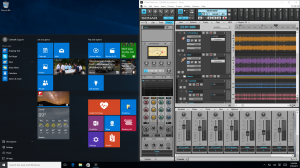Build 2017 was a blast – so much technology to absorb!
It was an honor to be the only DAW vendor to present some of the great strides we have made in SONAR to take advantage of the best in Windows technology.
Below is the session Cakewalk SONAR: Win32 lighting up on Windows 10
There were two presentations of this session. A bit nerve wracking doing a live demo with Bluetooth on a floor with thousands of people with BT devices 🙂 Fortunately everything went really smooth – BT MIDI performed flawlessly and I was able to connect from onstage and run at a buffer latency of less than 10 msec. It was very responsive. Pete let some people in the audience try playing the keyboard (a Korg Nanostudio) and everyone was impressed with how responsive playback was, even 20 feet away from the stage.
I even did a live walk through of the Bluetooth UWP MIDI stack from the SONAR code. The audience enjoyed seeing breakpoints being hit in response to playing notes on the keyboard. Nerd alert!
I also had a spot at the Solutions Spotlight at the event – kind of like NAMM for nerds! We had a small booth where we were showing SONAR and the technology and were available to answer questions. In the solutions spotlight session I paired a Jamstik controller in addition to the NanoStudio and it showed up as a second MIDI device. Both the keyboard and Jamstik were able to trigger different tracks without a problem.
It was great running into so many people from Microsoft and other tech companies like Adobe and Google who had used Cakewalk software.

